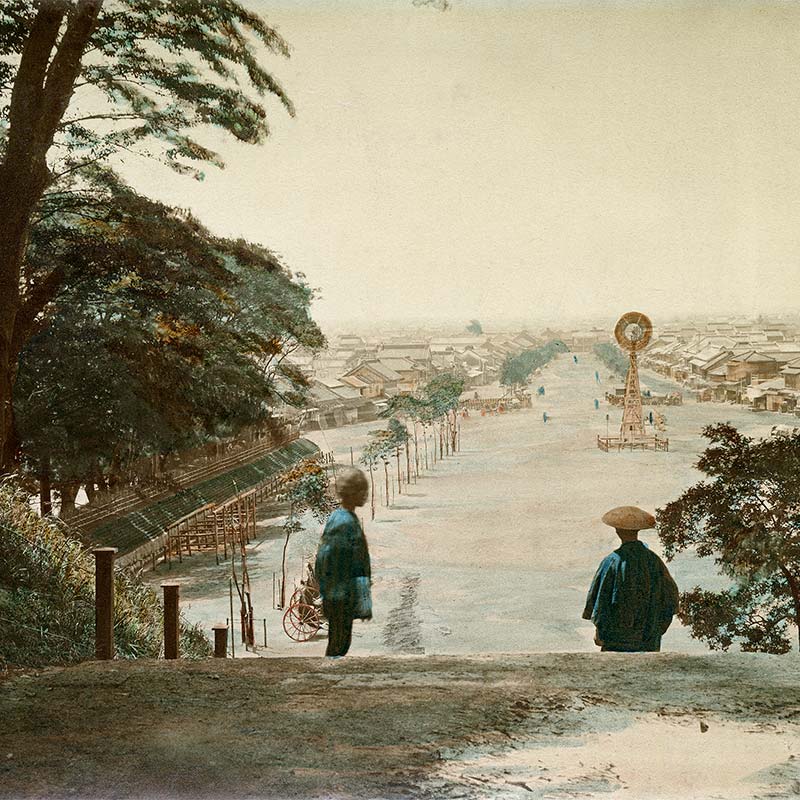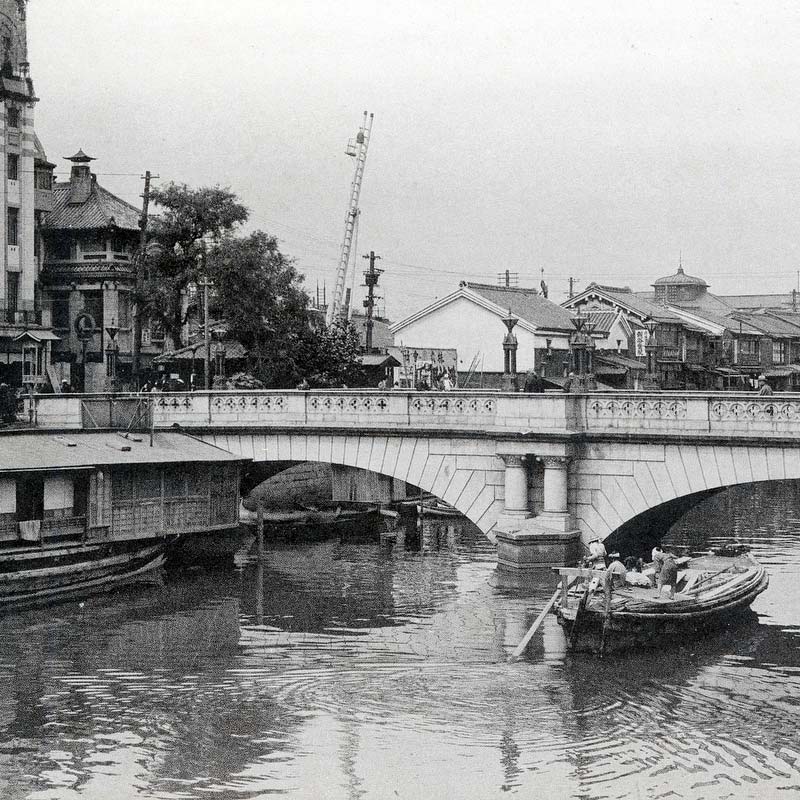Panoramic view on the southern part of the city of Nagasaki as seen from Mt. Kazagashira. The city is crowded with traditional style wooden buildings and the harbor is bustling with ships.
Dejima (also: Deshima) is visible on the right of the center of the photograph. The waterway separating it from the mainland appears to be the diverted Nakashima River. The building on the pier across from Deshima is the Customs House. The foreign settlement was located left of that.
Nagasaki was just a tiny village when a Portuguese ship landed in Kagoshima prefecture in 1542. This all changed when they established a trading port in 1571 with the assistance of the daimyo (feudal lord) Omura Sumitada (1533-1587). The village was soon transformed into an important harbor through which products from other Asian countries and Europe were imported. Bread, tobacco, and many other exotic products first entered Japan through Nagasaki. One of them, a Portuguese sponge-cake, became an important part of Nagasaki culture and is now known as Castella, a popular souvenir for visitors to the city.
In 1634, the artificial island of Deshima was made to accommodate Portuguese merchants. They were however, expelled from Japan in 1638 after a mostly Christian uprising in 1637. In 1641, Dutch traders who had been living on the island of Hirado were moved to Deshima. They were not allowed to enter the mainland, except for the annual visit to the Shogun in Edo (current Tokyo). The Dutch and the Chinese were the only foreigners allowed to live and trade in Nagasaki.
Over the following two centuries Japan was officially closed for contact with the outside world. Although the Tokugawa Shogunate also interacted and traded with the Ryukyus (current Okinawa), Korea and Russia during this period, Nagasaki became an important window on the world, and the city was seen as exotic and full of curiosities.
U.S. Commodore Matthew Perry‘s visit in 1853 forced Japan to once again open its doors to diplomatic relations and foreign trade. Just six years later, in 1859, Nagasaki became a free port.
Foreigners immediately started to enter the city and started to play a major role in its Westernization. A large foreign settlement was established in Umegasaki, Oura, Sagarimatsu, Higashiyamate and Minamiyamate, housing diplomats, traders, adventurers and missionaries who started many churches and schools.
Because of its proximity to China, which had several important trading ports dominated by European powers, Nagasaki initially played a leading role in the introduction of Western technology. Technologies for shipbuilding, coal mining, railroads, and even newspaper publishing were first introduced to Japan through this city. An especially influential role was played by the Scottish merchant Thomas Blake Glover, who would assist Japanese rebels in toppling the Tokugawa Shogunate.
The unique culture that developed in the city inspired Pierre Loti‘s 1888 novel Madame Chrysanthème, which became the inspiration for Giacomo Puccini‘s opera Madama Butterfly, both of which inspired a Japan boom in Europe and the US.
The Nagasaki foreign settlement was officially closed in 1899 when the unequal treaties that had given birth to them in several Japanese cities were abolished. But foreigners continued to live there and helped bring even more prosperity to the city. This prosperity was especially increased by the Sino-Japanese War (1894-1895), the Spanish-American War (1898) and the Boxer Rebellion (1899-1901).
The city’s prosperity however came to an abrupt halt when it was placed under special military supervision during the Russo-Japanese War (1904-1905). Ships stopped calling and trade basically collapsed. Foreign residents moved in increasing numbers to Yokohama and Kobe. Nagasaki’s position as the most important international port had already been taken over by Yokohama, and it was unable to recover its former glory.
The outbreak of World War II in 1941 was the final straw for the city’s once so vibrant foreign community. Virtually every Western resident left the city, never to return.
Published
Updated
Reader Supported
Old Photos of Japan aims to be your personal museum for Japan's visual heritage and to bring the experiences of everyday life in old Japan to you.
To enhance our understanding of Japanese culture and society I track down, acquire, archive, and research images of everyday life, and give them context.
I share what I have found for free on this site, without ads or selling your data.
Your support helps me to continue doing so, and ensures that this exceptional visual heritage will not be lost and forgotten.
Thank you,
Kjeld Duits
Reference for Citations
Duits, Kjeld (). Nagasaki 1890s: View on City and Bay, OLD PHOTOS of JAPAN. Retrieved on December 12, 2025 (GMT) from https://www.oldphotosjapan.com/photos/264/view-on-city-and-bay




Jessica Kryczka
very helpful for my Assignment, im glad to be on this website, it is very knowledable.
#000064 ·
Kjeld Duits (Author)
Thank you, Jessica.
#000066 ·